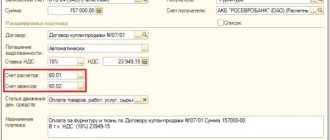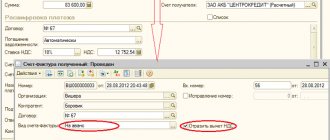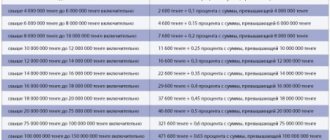Account 19 “Value added tax on acquired assets” is used to collect and process information about the tax paid or required to be transferred to the state budget. These amounts are included in the cost of the purchased property or material assets, as well as the services provided and work performed. The debit shows the amounts attributable to the purchase of property, and the credit shows the amounts accepted for deduction in correspondence with Dt 68.
The created products, works performed or services provided are sold to the buyer not at cost, but at the final price, which, in addition to cost, also includes added value. This premium represents the profit of the organization, which is used to expand the business or implement strategic decisions. The added value is subject to value added tax, which is displayed on account 19 “VAT on acquired values.”
It is active, and the following amounts are taken into account:
- the debit indicates the amounts collected for the purchase of tangible and intangible property;
- the loan takes into account the accumulated amounts, which will then be presented as a deduction.
With this approach, only the amount of tax is collected on the account, and the cost of the purchased property is indicated on accounts that are intended specifically for this.
| Subaccount | Name | Description of the subaccount |
| VAT on the purchase of fixed assets | Used when purchasing or constructing fixed assets, for example, buildings, structures, equipment or vehicles, as well as land | |
| VAT on the purchase of intangible assets | Used when purchasing intangible assets, for example, software, patents, copyrights, databases, trademarks | |
| VAT on the purchase of inventories | Used when purchasing various material and production resources, including semi-finished products, components, goods, raw materials and materials |
It should be noted that taxation arises both when purchasing property and selling one’s own products, and therefore there is a certain connection between these two operations. Account 19 is intended to display the tax on purchased material assets, and it can be used as a deduction. It corresponds according to Dt with property accounting accounts. The transfer of collected amounts (Kt 19) corresponds with Dt 68 “Calculations for taxes and fees”, where at the same time the tax on goods or products sold is collected.
Postings and operations
Business transactions and activities related to this issue are recorded in accounting account 19 with such entries as:
- Purchase of goods and materials
Dt 01,02,10 Kt 60 - reflects the cost of the purchased propertyDt 19 Kt 60 - indicates the tax on the purchased property
D 68 Kt 19 - indicates the tax that will be used as a deduction
- When selling products or goods
Dt 90 K 68 - sales tax is charged
| Score 19 | |||
| Debit | Credit | ||
| Cor. check | Description | Cor. check | Description |
| Kt 60 | VAT on purchased property is indicated | Dt 68 | The VAT to be deducted is indicated |
Moreover, if VAT is also established during the sale, then it is necessary to consider the formation of the result on account 68. Typical wiring can be presented as follows:
Dt 68 Kt 19 - 30,000 rub. (VAT to be deducted is displayed)
Dt 90 Kt 68 - 50,000 rub. (VAT required to be paid is displayed)
Result = 50,000 rub. — 30,000 rub. = 20,000 rub. according to Kt 68
The result means that this exact amount of value added tax must be transferred to the budget. When transferring, a posting is made Dt 68 Kt 51 - the purpose of payment indicates the standard wording “1/3 of VAT accrued for the 3rd quarter of 2021”
It should be noted that the amount of VAT on intangible assets or fixed assets can be deducted only if the acquired property is taken into account in full.
Victor Stepanov, 2016-12-06
General rules for accounting for excise taxes
Accounting and tax accounting for excise duties is carried out primarily by companies associated with the production of excisable goods, as well as processors of excisable raw materials and importers of similar goods.
Thus, the vast majority of taxpayers use excisable goods (for example, purchase gasoline), but do not keep separate records of them. The excise tax goes directly into the cost of the purchased goods and is reflected in the total amount.
How are excise taxes paid on fuels and lubricants (diesel fuel, gasoline) ?
For example, the manufacturer of a product specified by the Tax Code of the Russian Federation calculates the excise tax when selling a batch to a business partner. If the buyer then becomes a seller and resells the goods, there is no need to charge excise duty.
Note! Manufacturers of excisable goods cannot apply the Unified Agricultural Tax, except for producers of wine products from their own grapes (Article 346.2-6, paragraph 2). Also prohibited is the use of the simplified tax system (Article 346.12-3, paragraph 8), except for your own wine products. Taxpayers on imputation pay excise taxes on a general basis (Article 346.26, paragraph 4).
The procedure for recording excise taxes on BU accounts was clarified by the Ministry of Finance in letter No. 96 12/11/96 (p. 2):
- To account for excise taxes, the accountant uses account 19 with the opening of a c/o account “Excise taxes on paid MC” and account 68, using a c/account “Calculations for excise taxes”.
- The company is obliged to organize separate accounting of excise amounts for inventory items that have been capitalized and paid and for inventory items that have not been capitalized and not paid.
- In accounting registers of accounting departments, excise taxes should be highlighted in a separate column.
- Excise tax accounting must be structured in such a way as to ensure that correct information is obtained for preparing tax returns.
How are excise taxes paid on middle distillates ?
Formation of wiring Kt 19.04 Dt 68.02
IThe document “Receipt of goods and services” reflects the service and indicates the VAT account 19.04. As a result of the posting, the posting Dt 19.04 - Kt 60.01 is formed. An invoice has been entered based on the document. But for some reason this document does not end up in the “Creating Purchase Ledger Entries” document. And accordingly, the posting Dt 68.02 Kt 19.04 is not generated. Why? In general, only the invoice 19.03 is included in the “purchase book form”... Maybe something else needs to be indicated?
Try the new free service for quick code analysis of typical configurations 1c-api.com
ATTENTION!
If you have lost the message input window, press
Ctrl-F5
or
Ctrl-R
or the Refresh button in your browser.
The thread has been archived. Adding messages is not possible.
But you can create a new thread and they will definitely answer you!
Every hour there are more than 2000
people on the Magic Forum.
Purchase of equipment (microwave oven, heater)
Regulatory regulation
BOO
FSBU 5/2019 does not recognize office equipment as inventories. The organization, in accordance with its accounting policy, classifies acquired equipment as part of:
- fixed assets;
- expenses at the time of purchase.
One-time recognition of the cost of equipment as expenses can be justified by the requirement of rational accounting, provided that the data on it is insignificant in accordance with the criteria established in the organization (clause 7.4 of PBU 1/2008).
WELL
The taxpayer can take into account the costs of ensuring normal working conditions and safety measures provided for by law (clause 7, clause 1, article 264 of the Tax Code of the Russian Federation). There is no specific list of such expenses in the Tax Code of the Russian Federation, so you can take into account any expenses that meet this definition, including:
- purchase of drinking water and installation of coolers (Letter of the Ministry of Finance of the Russian Federation dated July 17, 2017 N 03-03-06/1/45286);
- purchase of climate control equipment (Letters of the Ministry of Finance of the Russian Federation dated October 2, 2015 N 03-03-06/56359, dated October 3, 2012 N 03-03-06/2/112);
- equipment of places for eating (clause 5.52 SNiP 2.09.04-87, Letter of the Ministry of Finance of the Russian Federation dated 09.26.2011 N 03-03-06/2/149).
VAT on expenses for ensuring normal working conditions and safety measures is accepted for deduction in the usual manner (clause 1 of Article 172 of the Tax Code of the Russian Federation).
Accounting in 1C
Reflect the receipt of inventory with the document Receipt (acts, invoices, UPD) document type Invoice, UPD (Purchases - Receipts (acts, invoices, UPD)).
Please indicate:
- Nomenclature - an element from the Nomenclature directory: Type of nomenclature - Inventory and household supplies ;
Postings according to the document
The document generates transactions:
- Dt 10.09 Kt 60.01 - household equipment accepted for accounting;
- Dt 19.03 Kt 60.01 - VAT accepted for accounting.
Postings Dt 68 and Kt 68, 19, 51 (nuances)
Naturally, the accounting department must have reasons for this. Firstly, such a basis may be the order of the manager, mentioned above. Secondly, this may be an order from the manager for a one-time payment of money. Thirdly, it could be his resolution (such as “pay”, “issue”) on some document (memorandum, invoice, etc.). A resolution can be put forward not only by the manager, but also by another person (deputy manager, chief engineer, branch manager, etc.). Other persons may give orders for the issuance of accountable amounts only if they are authorized to do so by order of the manager. In general, you should immediately clearly define the range of documents on the basis of which the accounting department issues expense vouchers for the issuance of accountable amounts.
Power of attorney
If a company issues a power of attorney to an employee, then he acts on behalf of his company, and all documents that he receives from other companies will be issued in the name of the company he represents. He will receive both a delivery note and an invoice (which will allow VAT to be offset). If an employee does not have a power of attorney, for other companies he is a private person. All this employee can count on is cash receipts and sales receipts. In either case, these expenses can be accepted by the business, but the accounting entries are slightly different. These differences will be shown in the journal entry table.
The power of attorney is issued in one copy, registered in a special register of powers of attorney and handed over to the employee, and the accountant remains with the spine of the power of attorney, which indicates all its details. Since the employee represents his home company in another organization, the power of attorney remains in that organization. When the employee returns to the employer, the accountant will make a note on the counterfoil of the power of attorney that the order has been completed.
The power of attorney indicates the date of its issue and validity period. If the power of attorney does not indicate a validity period, then such a power of attorney is valid for 1 year from the date of issue. If the power of attorney does not indicate the date of its issue, then such power of attorney is invalid. To receive material assets, power of attorney form No. M-2 has been approved (approved by Resolution of the State Statistics Committee of the Russian Federation dated October 30, 1997 No. 71a).
Date added: 2015-10-28; | Copyright infringement
Accounts | Four types of business transactions | Dt 50 Kt 51 1000 rub. | Who can tell an accountant | About company registration | About signatures and seals | Responsibilities of a cashier | Cash book | About cash register equipment (CCT) | Payment orders | mybiblioteka.su - 2015-2018. (0.009 sec.)
| Olya_KT | |
| zbv | Confa? |
| Olya_KT | 8.1.15.14 |
| Olya_KT | accounting |
| shuhard | (1) asked in vain |
| Olya_KT | boo 1.6.20.6(4) why in vain? |
| zbv | (3) in the accounting policy - Simplified VAT accounting - is used? (4) why? |
| Olya_KT | (6) no, don’t use it |
| zbv | (7) movement according to the VAT register submitted to the Receipt? |
| Olya_KT | (8) Yes, it is in the register |
| zbv | (9) is everything okay with the invoice? carried out? date of this period? |
| Olya_KT | yes, carried out, date matches |
| zbv | (11) well then... |
Subaccounts
For each type of tax that an organization is required to transfer, there is its own subaccount. According to the methods of calculation, taxes are usually divided into the following types:
- property - they are paid for the use of objects. These include land, transport, and equipment. Everything that is on the balance sheet of the organization. The tax amount is calculated based on the value of the taxable base. It is not affected by the firm's performance;
- indirect - they are included in the amount for a product or service. This includes VAT, customs duties and excise taxes.
68 subaccount account is used for fees and taxes that the company must transfer. They depend on the field of activity and the chosen tax regime. For each type of tax, your own sub-account must be opened:
- 68.13 - trade tax;
- 68.12 - simplified tax system;
- 68.11 - UTII.
Classification of subaccounts is made based on the instructions for using the plan. In general cases, the composition includes:
- income tax;
- water, transport, gambling;
- local contributions to the budget;
- single imputed;
- agricultural tax.
Also included in the subaccount of account 68 is property tax.
To the question, which personal income tax account is in the chart of accounts, the answer will be as follows. For the calculation and payment of personal income tax, a subaccount 68.1 is opened. All information about charges, deductions, payments and any value-added transactions is reflected in account 68 02.
If a company pays excise taxes, then a subaccount 68.3 is opened for them. For organizations operating under the general taxation system, 68.4 is required.
Organizations on the general taxation system that pay income tax open a subaccount 68.4 to record it.
Classification
Tax obligations of organizations
Payments for taxes and fees can be sent to the federal, regional or local budget. It depends on the type of obligation. Federal taxes include VAT, excise taxes, and income taxes. Local and regional taxes consist mainly of amounts assessed for the use of land and property.
When considering the tax obligations of an enterprise, it would be correct to systematize payments in the context of this economic entity. Let's group the main types of taxes and fees, data on which are entered into account 68 in accounting, according to the method of their payment:
- from the amount of sales proceeds - excise taxes, VAT, customs costs;
- write-off to the cost of products (works, services) - taxes on land, water resources, mining, on property and transport of an enterprise, gambling business;
- from net profit - corporate income tax.
In addition, account 68 is also used to pay personal income tax levied on the income of individuals (employees of the enterprise).
Depending on the tax regime under which the enterprise operates, payment rates and their total number change. For example, organizations using the simplified tax system may be exempt from paying VAT, property and profit tax, and personal income tax.
Write-off (transfer into operation) of household equipment
Write-off (transfer for operation) of household equipment is completed with the document Transfer of materials for operation in the section Warehouse - Transfer of materials for operation.
On the Inventory and Household Supplies , indicate:
- Nomenclature - inventory transferred for operation;
- An individual is a financially responsible person for equipment in operation;
- Method of reflecting expenses - the method of accounting for the costs of purchasing inventory, selected from the directory Method of reflecting expenses: Cost account - 26 “General business expenses”;
- Subconto is a cost item for which expenses will accumulate. Selected from the directory Cost Items, Expense Type - Other Expenses .





